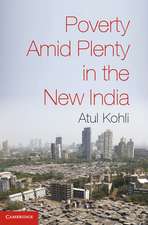Bazaar and State in Iran: The Politics of the Tehran Marketplace: Cambridge Middle East Studies, cartea 26
Autor Arang Keshavarzianen Limba Engleză Paperback – 18 mar 2009
| Toate formatele și edițiile | Preț | Express |
|---|---|---|
| Paperback (1) | 288.80 lei 6-8 săpt. | |
| Cambridge University Press – 18 mar 2009 | 288.80 lei 6-8 săpt. | |
| Hardback (1) | 848.22 lei 6-8 săpt. | |
| Cambridge University Press – 11 apr 2007 | 848.22 lei 6-8 săpt. |
Din seria Cambridge Middle East Studies
-
 Preț: 267.61 lei
Preț: 267.61 lei -
 Preț: 229.88 lei
Preț: 229.88 lei -
 Preț: 291.15 lei
Preț: 291.15 lei -
 Preț: 161.23 lei
Preț: 161.23 lei -
 Preț: 186.71 lei
Preț: 186.71 lei -
 Preț: 384.47 lei
Preț: 384.47 lei -
 Preț: 186.71 lei
Preț: 186.71 lei -
 Preț: 199.05 lei
Preț: 199.05 lei -
 Preț: 158.77 lei
Preț: 158.77 lei -
 Preț: 185.02 lei
Preț: 185.02 lei -
 Preț: 291.68 lei
Preț: 291.68 lei - 9%
 Preț: 628.34 lei
Preț: 628.34 lei - 8%
 Preț: 530.54 lei
Preț: 530.54 lei -
 Preț: 289.24 lei
Preț: 289.24 lei -
 Preț: 238.72 lei
Preț: 238.72 lei -
 Preț: 227.12 lei
Preț: 227.12 lei -
 Preț: 252.21 lei
Preț: 252.21 lei -
 Preț: 211.40 lei
Preț: 211.40 lei -
 Preț: 240.63 lei
Preț: 240.63 lei -
 Preț: 297.53 lei
Preț: 297.53 lei - 11%
 Preț: 581.66 lei
Preț: 581.66 lei - 11%
 Preț: 636.52 lei
Preț: 636.52 lei -
 Preț: 430.38 lei
Preț: 430.38 lei -
 Preț: 419.19 lei
Preț: 419.19 lei -
 Preț: 432.67 lei
Preț: 432.67 lei -
 Preț: 284.39 lei
Preț: 284.39 lei -
 Preț: 294.90 lei
Preț: 294.90 lei -
 Preț: 278.34 lei
Preț: 278.34 lei -
 Preț: 325.50 lei
Preț: 325.50 lei -
 Preț: 394.50 lei
Preț: 394.50 lei -
 Preț: 283.25 lei
Preț: 283.25 lei -
 Preț: 206.39 lei
Preț: 206.39 lei -
 Preț: 252.03 lei
Preț: 252.03 lei
Preț: 288.80 lei
Nou
Puncte Express: 433
Preț estimativ în valută:
55.28€ • 57.49$ • 46.32£
55.28€ • 57.49$ • 46.32£
Carte tipărită la comandă
Livrare economică 13-27 martie
Preluare comenzi: 021 569.72.76
Specificații
ISBN-13: 9780521103305
ISBN-10: 0521103304
Pagini: 324
Ilustrații: 3 maps
Dimensiuni: 152 x 229 x 18 mm
Greutate: 0.48 kg
Editura: Cambridge University Press
Colecția Cambridge University Press
Seria Cambridge Middle East Studies
Locul publicării:Cambridge, United Kingdom
ISBN-10: 0521103304
Pagini: 324
Ilustrații: 3 maps
Dimensiuni: 152 x 229 x 18 mm
Greutate: 0.48 kg
Editura: Cambridge University Press
Colecția Cambridge University Press
Seria Cambridge Middle East Studies
Locul publicării:Cambridge, United Kingdom
Cuprins
1. The puzzle of the Tehran Bazaar under the Pahlavi monarchy and the Islamic Republic; 2. Conceptualising the bazaar; 3. Bazaar transformations: networks, reputations and solidarities; 4. Networks in the context of transformative agendas; 5. Carpets, tea and teacups: commodity types and sectoral trajectories; 6. Networks of mobilisation under two regimes; 7. Conclusions; Selected bibliography; Index.
Recenzii
'Keshavarzian casts his study within an intelligent and provocative theoretical framework, while providing the reader with rich empirical detail … He makes new contributions to the study of the Tehran bazaar.' Ervand Abrahamian, Baruch College
'… no other work comes close to Keshavarzian's in its systematic treatment of the subject … it is likely to broaden the discourse on Iranian politics in the existing academic literature.' Massoud Karshenas, SOAS, University of London
'… a treasure of information, fine analyses, and comparisons … the fruit of dense and extensive anthropological field research. … should be read not only by Iran specialists, but by anybody interested in economic institutions in Islamic countries or in the link between economic, social, and cultural practices.' Fariba Adelkhah, Iranian Studies
'Keshavarzian shows how the bazaar exercised its political and economic influence under the shah. He then lays out the paradox that the revolution in which the bazaar was so central brought in a government that has systematically weakened the bazaar to the point that the bazaar is no longer a significant political player. … [Keshavarzian] provides lots of colorful details.' Foreign Policy
'… no other work comes close to Keshavarzian's in its systematic treatment of the subject … it is likely to broaden the discourse on Iranian politics in the existing academic literature.' Massoud Karshenas, SOAS, University of London
'… a treasure of information, fine analyses, and comparisons … the fruit of dense and extensive anthropological field research. … should be read not only by Iran specialists, but by anybody interested in economic institutions in Islamic countries or in the link between economic, social, and cultural practices.' Fariba Adelkhah, Iranian Studies
'Keshavarzian shows how the bazaar exercised its political and economic influence under the shah. He then lays out the paradox that the revolution in which the bazaar was so central brought in a government that has systematically weakened the bazaar to the point that the bazaar is no longer a significant political player. … [Keshavarzian] provides lots of colorful details.' Foreign Policy
Notă biografică
Descriere
Keshavarizian's book affords unusual insights into the politics, economics and society of Iran across four decades.


















